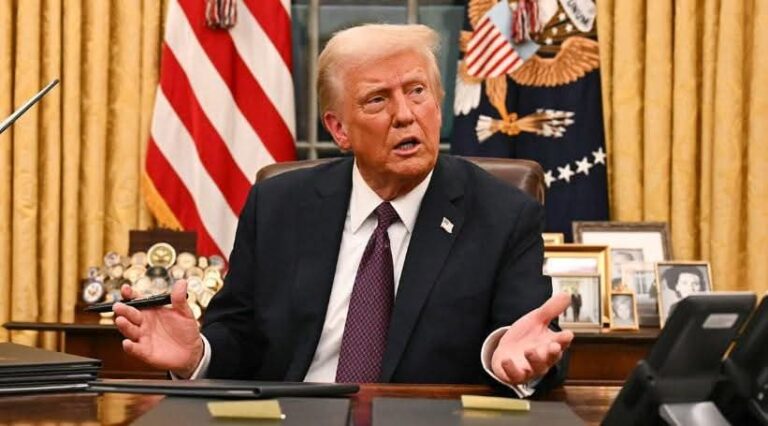Donald Trump’s decision to distance himself from negotiations surrounding the war in Ukraine—while simultaneously engaging in direct talks with Hamas—marks a major shift in American foreign policy behavior under his leadership.
I. Trump’s Withdrawal from Ukraine Peace Efforts
A. Political and Strategic Motivations
- Desire to Differentiate from Biden’s Foreign Policy
Trump seeks to reject Biden’s multilateral, NATO-aligned approach to Ukraine. By disengaging from conventional diplomacy, he positions himself as an “anti-establishment” alternative, claiming that “Europe’s war is not America’s responsibility.” - Focus on Domestic Politics
With an eye on the 2024/2028 electoral base, Trump prioritizes domestic economic issues and immigration over costly international commitments. Ukraine fatigue among parts of the Republican base plays directly into this disengagement. - Transactional View of Alliances
Trump views NATO and Ukraine through a cost-benefit lens. Since Ukraine is not a NATO member, he sees no strategic need to expend U.S. political capital without direct benefit—especially if European states are unwilling to “pay their share.”
B. Tactical Calculations
- Trump believes Russia can be contained through personal diplomacy, not alliance-driven escalation. His approach implies that he sees Putin as someone he can “deal with,” not an existential threat requiring long-term containment.
II. Direct Talks with Hamas: Strategic Disruption or Symbolic Power Play?
A. Motivation Behind Engagement
- Disruption of the Traditional U.S. Approach to the Middle East
Trump’s outreach to Hamas is designed to bypass both the Palestinian Authority and traditional Arab allies like Jordan and Egypt. It mirrors his previous move to speak directly to the Taliban, positioning himself as a peacemaker who succeeds where others fail. - Undermining Iran’s Leverage
By talking to Hamas—an Iranian proxy—Trump may believe he can fracture the Tehran-led axis, offering Hamas alternative incentives to weaken Iran’s strategic hand.
III. Strategic Implications
A. Damage to U.S. Credibility
- Trump’s simultaneous abandonment of Ukraine diplomacy and outreach to Hamas creates a perception of inconsistency and unpredictability. Allies may question U.S. reliability, while adversaries may interpret disengagement as weakness or lack of resolve.
B. Undermining of U.S. Allies
- Europe
Trump’s abandonment of Ukraine will deepen divisions with NATO members and embolden Russian aggression in Eastern Europe. It signals to Poland, the Baltics, and Romania that U.S. support is conditional and fragile.
- Israel and Moderate Arab States
Engaging with Hamas risks alienating Israel and undermines the Abraham Accords. It could also destabilize relationships with Egypt and Jordan, who oppose legitimizing Hamas diplomatically.
C. Shift in U.S. Global Image
- The dual approach reinforces an image of the U.S. as a transactional, unpredictable actor, abandoning liberal norms for short-term gains. It further distances the U.S. from its post-WWII role as a consistent defender of international law and liberal democracy.
IV. Long-Term Risks
- Erosion of Deterrence
If Ukraine is deprioritized while groups like Hamas are legitimized, authoritarian regimes and non-state actors may believe the U.S. is no longer willing to uphold international norms unless directly threatened. - Loss of Multilateral Influence
The U.S. risks ceding ground to other powers—especially China and Russia—in Europe and the Middle East. This opens space for alternative security arrangements that exclude Washington. - Encouragement of Proxy Warfare
Ignoring Ukraine while engaging actors like Hamas sets a dangerous precedent: groups operating outside the state system may see recognition and legitimacy as achievable through violence.
Trump’s foreign policy shift—distancing from the Ukraine conflict while opening channels to Hamas—reflects a deep recalibration of U.S. global posture. Though it appeals to isolationist instincts and anti-establishment voters, it threatens to dismantle decades of bipartisan strategic doctrine. The result is a less predictable, more vulnerable global order with weakened alliances, empowered adversaries, and a U.S. foreign policy increasingly driven by political optics rather than strategic coherence.
Policy Recommendations
- For U.S. Institutions:
- Congress should assert its role in foreign policy by mandating consistency in engagement with allies and adversaries.
- Preserve bipartisan support for Ukraine aid and clarify limits on executive engagement with terrorist-designated groups.
- For NATO and the EU:
- Increase autonomy in defense funding and policy planning to prepare for a potential U.S. retrenchment.
- Launch coordinated messaging campaigns to counter disinformation about U.S. withdrawal narratives.
- For U.S. Diplomats:
- Quietly reassure traditional allies (Israel, Poland, Baltic States) of America’s long-term commitment, regardless of executive branch signals.
- Prepare contingency plans to maintain support for Ukraine if the White House deprioritizes the conflict.
1. Historical Precedents
Trump’s disengagement from Ukraine and outreach to Hamas with past U.S. decisions that had similar consequences:
- Nixon’s outreach to China while abandoning Taiwan’s seat at the UN.
- Reagan’s support for mujahideen groups while deprioritizing traditional alliances.
2. Russian and Chinese Response
How Russia and China are likely to exploit this U.S. repositioning:
- Russia: Framing Trump’s pullback as a strategic victory in Ukraine and an erosion of NATO resolve.
- China: Promoting its model of “non-aligned mediation” as an alternative to U.S. diplomacy, especially in the Middle East.
3. Hamas’s Perspective and Strategy
Why Hamas is engaging with Trump and how they may be using these talks:
- To gain international legitimacy outside the UN framework.
- To exploit rifts between U.S. and Israel or the Arab League.
4. Impact on U.S. Domestic Political Consensus
How Trump’s actions might further polarize U.S. foreign policy:
- Weakening bipartisan support for Ukraine and Israel.
- Creating long-term inconsistencies in U.S. commitments based on presidential cycles.
5. Potential Scenarios
- Scenario A: Trump fully cuts off support for Ukraine, forcing a negotiated settlement favoring Russia.
- Scenario B: Trump’s outreach to Hamas backfires, leading to escalation in Gaza or Israeli disengagement from U.S. strategy.
Scenario C: U.S. allies begin to form “Plan B” security arrangements without Washington.




